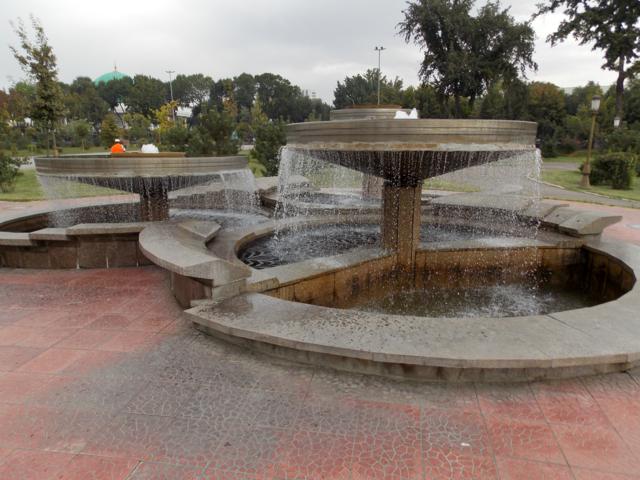Plecand de la hotel spre Piata Independentei, prima fantana apare chiar in parcul din jurul monumentului lui Amir Timur.

Si la intrarea in Piata Independentei sunt fantani dar nu functioneaza. In apropierea Monumentului Independentei sunt mai multe fantani, in jurul carora trebaluiesc echipe de femei, imbracate in uniforme verzi, caracteristice (mai vazusem si la alte spatii verzi).

Monumentul Independentei este reprezintat de un piedestal inalt pe care se afla o coloana care poarta in varf cu glob din bromz, pe care se distinge harta Uzbekistanului. Intregul monument este di granit rosu. In fata, este asezata o femeie tanara cu un copil in brate, reprezentand tanarul stat si viitorul sau. Monumentul a fost ridicat in 1992, la un an dupa declararea independentei.
Monumentul Independentei, 1992

Nu departe, o cladire in stil clasic adaposteste Senatul republicii. In fata sa, o fantana mare prilejuieste catorva tineri o “baie” inedita.
in fata Senatului
zile calde de septembrie

In partea de rasarit a parcului, un complex monumental, construit in 1999, este dedicat celor 400000 de soldati uzbeci, cazuti in cel de-al doilea razboi mondial. O femeie indurerata, reprezentand tara care isi plange fiii, are in fata o flacara vesnica. Monumentul este incadrat pe doua laturi cu coridoare deschise, cu acoperisul sprijinit de stalpi traditionali. Pe un coridor, nisele din perete adapostesc carti cu file din cupru, pe care sunt scrise numele tuturor celor care nu s-au mai intors din razboi. E cu adevarat impresionant sa vezi atatea nume! Realizezi astfel mult mai bine intreaga grozavie a unui razboi.
Monumentul celui de-al doilea razboi mondial, 1999





Am mai spus ca Tashkentul – asa cum il vedem astazi – este un oras relativ nou, construit dupa cutremurul de magnitudine 9 pe scara Richter, care l-a lovit in dimineata zilei de 26 aprilie 1966, ora 5.23,distrugandu-l aproape in intregime. Din fericire, au fost putine victime omenesti pentru ca majoritatea caselor erau din pamant si nu mai inalte de un etaj. Pagubele s-au intins pe o raza de 10 km patrati. Locuitorii sunt obisnuiti cu asemenea fenomene deoarece aici, la poalele Muntilor Tien Shan, chiar sub oras, se afla o importanta falie tectonica. Nici un cutremur de pana acum nu a mai avut insa aceasta magnitudine! Monumentul Curajului a fost ridicat la 10 ani dupa cutremur (1976) si este alcatuit dintr-un bloc din labradorit negru, care poarta inscrise data si ora sinistrului. O crapatura merge pana la baza monumentului, semnificand cutremurul. O femeie isi tine in brate pruncul si incearca sa il fereasca cu mana. In fata sa, barbatul, ii apara cu corpul sau, pe amandoi.

Monumentul Curajului, 1976




On the Silk Road in Uzbekistan 9. Tashkent – Monuments and Fountains
The first fountain we have seen in the park around the Amir Timur monument. There are a lot in the city. The water and the noise it makes brings a cool air around them, which is great in the hot summer day. Even now, on September, it was pleasant.
The Independence Monument, made of red granite, was constructed on 1992, one year later after Uzbekistan proclaimed its independence from the Soviet Union. On the pedestal, a column bears a bronze globe with the Uzbekistan map. A young mother with a little child on her lap represents the young independent country and its future.
In front of the near-by building of the Senate, a long, big, fountain is the playground of young people. There are many fountains in the Independence square/park.
To the eastern part of the park, the complex of WW2 is an interesting monument, partly with traditional elements. It consists of the sad mother’s monument, mourning his sons and an eternal flame. During the WW2, 400000 Uzbek soldiers lost their lives on the front. Their names appear on copper pages of books in an open gallery near-by. The complex is really impressive. It was constructed on 1999.
Not far from here, the Earthquake Memorial or the Monument of Courage reminds on the terrible earthquake on 26 April 1966. It has the magnitude of 9 on the Richter’s scale and produced damage on a surface bigger than 10 sq.km. Luckily there were few human victims, because almost all the buildings have been earthen ones, with no more than one level. A labradorite cube, split in two, indicates the day and the hour of the disaster. The monument itself shows a mother with a child whom she tries to protect with her raised hand. In front of them, the man protect them both with his body. All these monuments are places were people come and put flowers and young couples take their wedding photos.


magnifique endroit !
Merci bine, Audrey!
Superbe sunt acele fantani, nu mi-as i imaginat ca orasul este asa de frumos.Cand spui Tashkent, te gandesti la capatul Lumii, dar inca o data se dovedeste ca aparentele insala.
MMMultumesc ca m-ai luat si pe in aceasta vizita pe acest taram necunoscut mie ….
Multumesc pentru comentariu, cartim! Ma bucur ca iti place. Urmareste in continuare serialul, urmeaza alte orase de pe drumul matasii din Uzbekistan:)
Very meaningful photographs! I’m amazed by how many countries and people have their own stories, accounts and memories of WW2. I find it all very interesting..
Superb fountains!
You are right, Duncan! The stories and memories are different, depending who they were. Thanks for the comment!
Thanks for the visit, rama!
The sculptures are quite unusual…
They express pretty well the theme, VP. Thanks!
The fountains are amazing!
And useful too…
Fountains and gardens are my favorite! I love seeing them in the various countries that you visit. We grow cana lilies here at my house too :^) Beautiful post TH!
Thank you, Doug! I like Canna too:)
Though this is very nice all the fountains. And you may have some even walk. Very nice blog with some really nice pictures Traveling Hawk
Traveling Hawk
Thanks a lot, Helma!